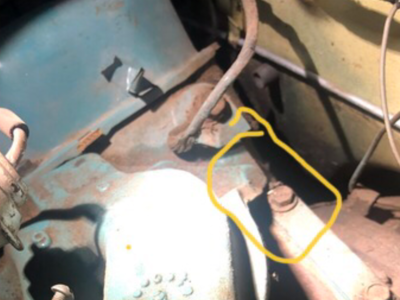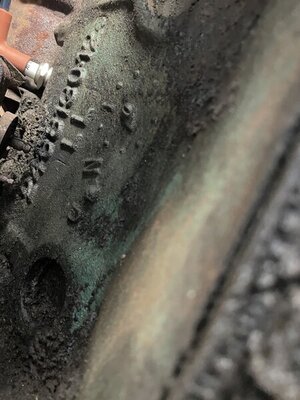Just got a call from a buddy with a 70 Bee with a 440. It was a dog. A fuel filter took care of it. Back to smoking tires!A doggy engine could be something as simple as a fuel filter. That carb looks like a Quadrajet and it and the intake could have come from a Motor home or the like. ANd 440 intakes don't fit on 383's. You have some sorting out to do.
You are using an out of date browser. It may not display this or other websites correctly.
You should upgrade or use an alternative browser.
You should upgrade or use an alternative browser.
Just purchased a '67 Coronet 440, and it's slow...
- Thread starter chillbill
- Start date
I can see you have a B engine block, 361, 383, 400 by how close the end rail bolt is to the intake. A 440 is wider than that and will have the end rail extended past the bolt.
why is it a dog? Dozens of reasons from not getting full throttle, secondaries not opening, timing problem, distributor problem, kinked fuel line, vacuum leak, dead hole, etc. Do you have 2.76 gears with tall tires? That will make it a dog.
Could cost $1.00 or $5000 to fix. Look it over and figure it out.
It could be rejecting the GM carb from a 250 cubic inch engine. I’ve a Q-jet from a 472 Caddy, that might work better.
View attachment 1128739

why is it a dog? Dozens of reasons from not getting full throttle, secondaries not opening, timing problem, distributor problem, kinked fuel line, vacuum leak, dead hole, etc. Do you have 2.76 gears with tall tires? That will make it a dog.
Could cost $1.00 or $5000 to fix. Look it over and figure it out.
It could be rejecting the GM carb from a 250 cubic inch engine. I’ve a Q-jet from a 472 Caddy, that might work better.
View attachment 1128739

Last edited:
chillbill
Active Member
chillbill
Active Member
There should be a pad in front on the block that will say 440. Also, if that is a #'s car, the VIN should tell you what kind of engine is in it as well as the fender tag if it has one. I've had fuel leaks and it will make the car run crappy. Where's the leak coming from? You need to fix it because that and that plastic fuel filter are a fire hazard. I'm definitely no expert, but have had similar problems. Vacuum leaks will cause it to run lousy too. Make sure the carb bolts are snug. Original gas tanks can have crud in them that restricts fuel and can really F things up in your carb. Definitely check the plugs.
The vin decoder says it's a 383. The previous owner swears it's the original engine.
The plastic fuel filter was replaced with the metal one after the pic above. Also, the car has a new gas tank and fuel lines.
I've cleaned the carb and will try to figure out where the leak is.
The first thing I would do is a compression test.
69 Sleeper Bee
Well-Known Member
From what I am seeing a "3830949" Intake comes up as a 1975-1976 400 B block intake but with an "F" beyond the #
It looks like your has a "D" so may be an earlier year. This one on ebay is a magnum truck / chrysler cordoba.
https://www.ebay.com/itm/223853127279?hash=item341eafa66f:g:epQAAOSwmFVeHmfI
It looks like your has a "D" so may be an earlier year. This one on ebay is a magnum truck / chrysler cordoba.
https://www.ebay.com/itm/223853127279?hash=item341eafa66f:g:epQAAOSwmFVeHmfI
diesel_lv
Well-Known Member
So what you have is a 383 w a 75-76 400 thermoquad intake. Even if that carb is from a 4.3 GM V6, if it is tuned properly, will have excellent off the line w an automatic. So if it's a dog, the many above suggestions should be tried from least invasive to most.
chillbill
Active Member
So what you have is a 383 w a 75-76 400 thermoquad intake. Even if that carb is from a 4.3 GM V6, if it is tuned properly, will have excellent off the line w an automatic. So if it's a dog, the many above suggestions should be tried from least invasive to most.
I'll start by checking the plugs and timing. The distributor cap and rotor look to be in good shape.
What's the proper timing for these engines? Also, what's a good source for this kind of info? Manual? Some website?
And I guess I can change the fuel filter too and get that out of the way.
I just purchased my first classic Mopar, a 1967 Coronet 440 with 87k miles, a stock 383, 4bbl carb, 3 speed 727 torqueflite, and a 8 3/4 rear end.
This was originally a 2bbl so I believe it was originally rated at 280hp. However, right now it feels more like 150hp. The first gear acceleration is "fine", but it feels the car starts to become sluggish after 30mph and acceleration decreases. I'm not expecting it to perform like a modern car but I think this motor can do better.
Last night I checked the numbers and the intake is a Chrysler unit from a 440, with number
3830949. The carb is a Rochester Quadrajet 17086046. This is a GM carb that came on 4.3l trucks. https://www.carburetion.com/CarbNumber.asp?Number=17086046
I'm not an expert here but I think this intake and carb combo is not the most efficient. Are there any power/torque gains to be had with a different carb? I know it's a stock, tired engine with a 3 speed but I'm sure it can do better.
Any suggestions?
I'm surprised at how often we're seeing posts today from folks that have recently acquired an factory original, low milage, unaltered or relatively unaltered car.
Do you know the detailed history of the car since 1967? Was it driven 1,500 miles per year for 54 years, or was it driven 10,000 mi/year (typical for that time period) for 9 years and then stored since 1976 for 45 years?
I started in this hobby in 1975. By 1980, I had 5 late 1960's and one 1970 Mopars. 80K at that time was considered lower than normal milage.
Just be open to maybe it not being exactly what has been stated.
Finally, be open to there not being anything wrong. Especially if someone has been in the motor in the last 54 years (i.e. highly likely). A 1967 B body car with a 383 2 bbl would be slower than a late model Dodge minivan.
And if the cylinders read 100- 110 psi you can spend time and money on ignition and carbeuration and it will still be sloooowwww.
diesel_lv
Well-Known Member
I must've been extremely lucky. I inherited my '67 4dr from my Great grandmother, 383 2bbl auto. I changed it to electronic ignition and dual exhaust the week I got it in '96. It had 78k original miles, yes it had been parked and driven once a month for many yrs before I got it. But it would legit take a stock 5.0 light to light with only that done.I'm surprised at how often we're seeing posts today from folks that have recently acquired an factory original, low milage, unaltered or relatively unaltered car.
Do you know the detailed history of the car since 1967? Was it driven 1,500 miles per year for 54 years, or was it driven 10,000 mi/year (typical for that time period) for 9 years and then stored since 1976 for 45 years?
I started in this hobby in 1975. By 1980, I had 5 late 1960's and one 1970 Mopars. 80K at that time was considered lower than normal milage.
Just be open to maybe it not being exactly what has been stated.
Finally, be open to there not being anything wrong. Especially if someone has been in the motor in the last 54 years (i.e. highly likely). A 1967 B body car with a 383 2 bbl would be slower than a late model Dodge minivan.
Dump that carb, and go with an edelbrock 1406, 650 CFM unit. I have a rebuilt one if you need it. Electric choke makes for a great upgrade.
It's a spreadbore manifold I believe...Dump that carb, and go with an edelbrock 1406, 650 CFM unit. I have a rebuilt one if you need it. Electric choke makes for a great upgrade.
....offf, then no the 1406. But in truth, it would be happier with it. I've got an extra 67 cast manifold too.......heavy sucker....It's a spreadbore manifold I believe...
I must've been extremely lucky. I inherited my '67 4dr from my Great grandmother, 383 2bbl auto. I changed it to electronic ignition and dual exhaust the week I got it in '96. It had 78k original miles, yes it had been parked and driven once a month for many yrs before I got it. But it would legit take a stock 5.0 light to light with only that done.
Not lucky at all. Just not common, even 25 years ago. Today, after 54 years, is it still unmodified factory original with 78K?
And not saying it cannot happen today
Last edited:
And if the cylinders read 100- 110 psi you can spend time and money on ignition and carbeuration and it will still be sloooowwww.
As you mentioned earlier, a cylinder pressure test would tell a lot.
diesel_lv
Well-Known Member
Oh Hell No!!! I parked it the next yr w 92k. I drove it like crazy that yr. Then it sat until last June. During that time I rebuilt everything mechanical. Engine is now 496 stroker. 96k miles on it now. But it'll never be sold. Pass it down to my grand or great grandchildren. Not until the DMV refuses to give me a license anymore though.Not lucky at all. Just not common, even 25 years ago. Today, after 54 years, is it still unmodified factory original with 78K?
And not saying it cannot happen today
Oh Hell No!!! I parked it the next yr w 92k. I drove it like crazy that yr. Then it sat until last June. During that time I rebuilt everything mechanical. Engine is now 496 stroker. 96k miles on it now. But it'll never be sold. Pass it down to my grand or great grandchildren. Not until the DMV refuses to give me a license anymore though.
Perfect. Use it and have fun!
chillbill
Active Member
I managed to pull only two plugs (this is harder than I expected) on the driver side and they don't look bad to me. They're cheap Autolite 85s and probably not gapped correctly.
Will try to pull the others over the weekend.

Will try to pull the others over the weekend.
chillbill
Active Member
Speaking of gaps, I think i should check and adjust the valve clearances too.
What gap should it be? And again, what’s a good source for this kind of information? A shop service manual?
What gap should it be? And again, what’s a good source for this kind of information? A shop service manual?
Similar threads
- Replies
- 35
- Views
- 4K
- Replies
- 49
- Views
- 2K
- Replies
- 20
- Views
- 1K
















